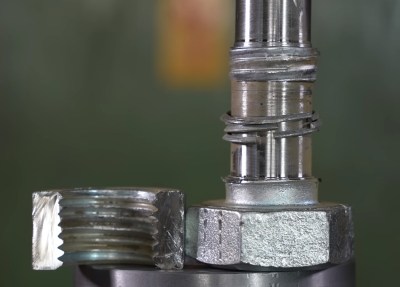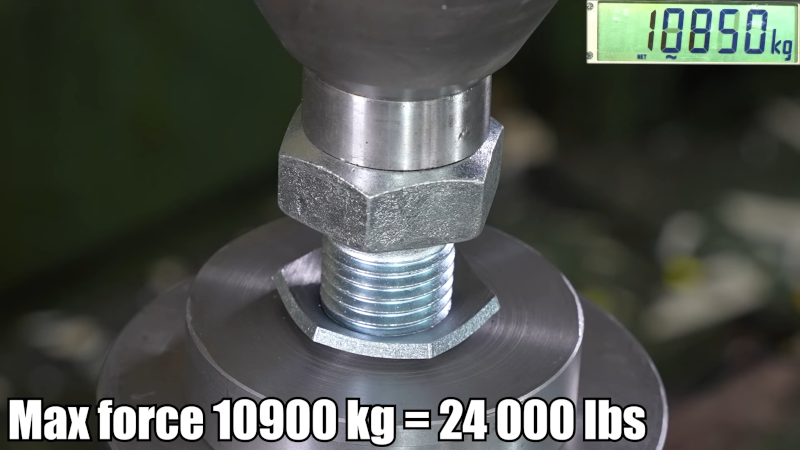Have you ever wondered how many threads a nut needs to be secure? [Hydraulic Press Channel] decided to find out, using some large hardware and a hydraulic press. The method was simple. He took a standard nut and cut the center out of it to have nuts with fewer threads than the full nut. Then it was on to the hydraulic press.
As you might expect, a single-thread nut gave way pretty quickly at about 10,000 kg. Adding threads, of course, helps. No real surprise, but it is nice to see actual characterization with real numbers. It is also interesting to watch metal hardware bend like cardboard at these enormous pressures.
 In the end, he removed threads from the bolts to get a better test and got some surprising results. Examining the failure modes is also interesting.
In the end, he removed threads from the bolts to get a better test and got some surprising results. Examining the failure modes is also interesting.
Honestly, we aren’t sure how valid some of the results were, but it was interesting watching the thread stripping and the catastrophic failures of the samples in the press. It seems like to do this right, you need to try a variety of assemblies and maybe even use different materials to see if all the data fit with the change in the number of threads. We expect the shape of the threads also makes a difference.
Still, an interesting video. We always enjoy seeing data generated to test theories and assumptions. We think of bolts and things as pretty simple, but there’s a surprising amount of technology that goes into their design and construction.
















The single threads on the bolt take less force because the process of removing the other threads on the lathe leaves sharp transition points at the end and beginning of the thread, which crack easily. Instead of deforming and adapting to the shape of the internal threads on the nut, the threads get peeled off starting from the ends. The same effect happens for the nut as well – the end threads are easier to shear off than the middle parts, so the strength grows more than twice when adding twice the threads.
To prevent the effect, the thread should gradually taper to flat – but then defining how many threads you have isn’t so simple.
I’m partial to Higbee starts, myself.
The shallower the taper, the more smoothly it transfers the forces to the base cylinder and the stronger it will be.
Suppose for example that 10% off the ends of the thread is basically “gone” because it’s too weak against shearing. That way the single thread case represents 80% of a complete thread.
When you double that, you get 1.8 complete threads, which is 2.25 times stronger. Four threads is equivalent to 3.8 complete threads, which is 2.11 times stronger than two. Keep doubling the number of threads and the increase in strength approaches the ideal 2:1 ratio – but eventually it deviates in the other direction and doubling the number will no longer double the strength because as your thread gets longer it also strains and the stresses are distributed unevenly.
That’s why I always avoid using a tap or die to chase threads unless it’s absolutely necessary. Stress risers abound.
If you cut a longitudinal groove in a bolt or use a castle nut upside down and run that through with some light lubrication, it’ll clear schmutz and mild deformation without creating stress points.
A lot of mechanics, especially backyarders, don’t put a lot of thought into hardware condition, which I suppose is one of the reasons automotive hardware tends to be so oversized. I couldn’t believe how small some of the hardware was when I transitioned into aviation!
I was puzzled by this, my dad always told me that 4 threads was enough. (Which is something he had been taught during his apprenticeship / HNC)
I think that a similar test done in tension might have been more instructive, as it’s not common to use a nut in compression.
I think that 4 nut threads is typically enough to snap (rather than strip) the bolt, it’s a simple equation of comparative areas in shear. (And as such isn’t a fixed number of threads, as 4 threads of fine thread is less shear area than 4 threads of coarse, but conversely has a significantly greater effective diameter)
I was taught as a rule-of-thumb that as long as the thread engagement was as deep as the bolt is wide, it was roughly as strong as the bolt.
“as it’s not common to use a nut in compression.”
Yeah, I was wondering that too!
when all you have is a hammer everything looks like a nail
Actually he said at the end that he’s gonna try and rig something to make it a tension set up
These nuts were tested in tension, just tension in the opposite direction along the bolt than normal (up the shaft rather than down it). If they’d inserted the bolt from the underside of the base of the test rig and pushed against the ‘headless’ end it would be in the same tensile situation as a normally tightened nut, but as the threadforms tested are symmetrical it makes to functional difference.
While if this was a rigid body problem you’d be correct, the bolt itself is deforming slightly, too. A bolt in compression will bulge, while one in compression will thin out and stretch slightly. This change in shape can affect the loads experienced by the threads.
This is less significant when the threaded length is shorter, as the axial deformation becomes negligible due to the low forces.
The load on the nut is the same. The load on the bolt is different, compression rather than tension.
This whole question is comparing the strength in shear of the threads of the nut (and bolt) with the strength in tension (or compression) of the bolt.
The compressive strength of a bar is typically rather higher than the tensile strength (once the elastic limit is reached) as in the compressive case the cross sectional area increases, whereas in tension it decreases.
As others have said, at some number of threads the nut is strong enough to stretch and snap the bolt. This test never explores that limit.
2 1/2 min. What’s the material ?
This test should have been done by using washers between the nut and a rigid thick bar to limit the number threads engaged then the nuts tightened to torque consistent the the rating of the nut and bolt combination then the bolt pulled until failure for a test as used scenario. Thining the nuts reduced their strength and they would deform under pressure contributing to failure
Sometimes I wonder that, then I look it up in the Pocket Ref table.
This is an engineering rabbit hole, how many threads per inch, rolled or cut, hardened or soft, fine or standard pitch.
It amazes me how people often don’t have a grasp on how threads work at all let alone the variables.
I currently am looking to 3D print some BSPP for water cooling, because of course 19 threads per inch is a sane number of threads for a face sealed water fitting. Why not also call it g1/4 so it is easy to get search results as well?
Also see the Torque Test Channel on Youtube, they recently did a couple rounds of testing on headbolts. Between Subaru, Toyota and GM I know a few engine series have had head sealing issues.
They even test some really high-zoot ARP stuff. But also some more reasonable ones that are an upgrade to stock.
https://youtu.be/VlfVt1wqr40
Hopefully you are recommended their threadsert vs helicoil video and the follow up video on if tapping the stud after tightening relaxes the bolt. And yes, they test them in tension, many of them to failure.
Odd way to test thread strength. Of all the years I spent as a toolmaker, we always went by the rule the engineering department went by. Threads should be 1-1/2 times the bolt diameter to achieve maximum strength. That’s enough for the bolt to snap before the threads tear out. Although, I have gotten some cheap Chinese hardware that wouldn’t hold up no matter how deep you went with the threads, almost like they were made of lead, lol.